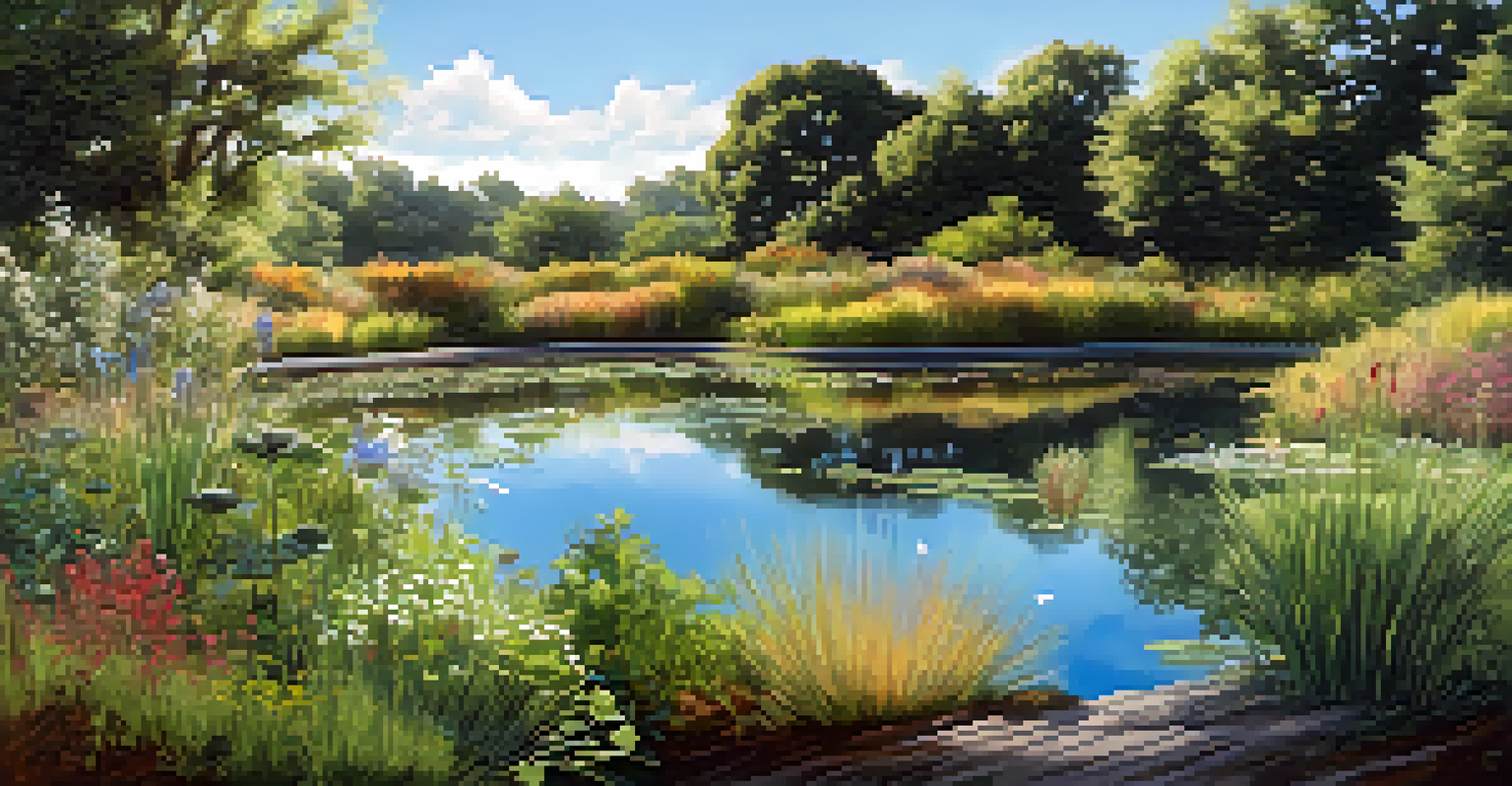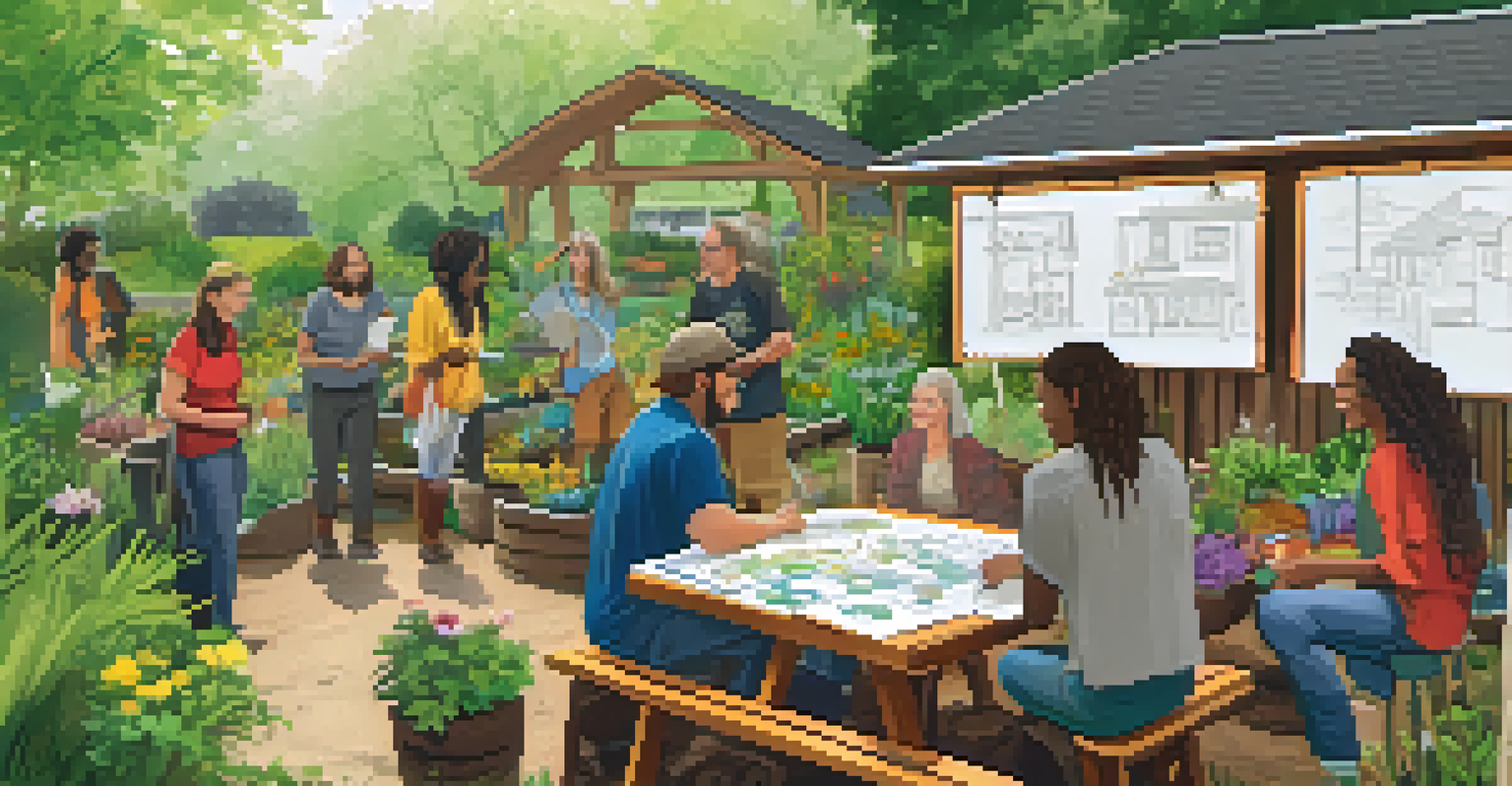Water Management: Key Strategies in Permaculture Design

Understanding the Importance of Water in Permaculture
Water is a fundamental resource in any ecosystem, and in permaculture, it becomes even more critical. Proper management of water can help create a sustainable environment that supports diverse plant and animal life. By understanding how water moves through the landscape, permaculture designers can make informed decisions that enhance ecosystem resilience.
Water is the driving force of all nature.
In permaculture, the goal is to work with natural systems rather than against them. This means recognizing the patterns of rainfall, runoff, and evaporation in your area. By observing these patterns, you can design systems that capture and utilize water effectively, ensuring that it nourishes your plants and doesn't go to waste.
Ultimately, effective water management can lead to healthier ecosystems, increased biodiversity, and improved soil health. When designed thoughtfully, your permaculture system can thrive even in the face of droughts or heavy rains.
Rainwater Harvesting: A Sustainable Solution
Rainwater harvesting is a key strategy in permaculture that allows you to collect and store rainwater for later use. This technique not only reduces dependency on municipal water supplies but also helps to mitigate flooding and erosion. By capturing rainwater, you can provide a consistent water source for your plants, especially during dry spells.

Setting up a rainwater harvesting system can be as simple as installing gutters and barrels to collect runoff from your roof. You can then use this stored water to irrigate your garden or landscape, making the most of a free and renewable resource. Additionally, this practice can help recharge groundwater supplies, benefiting your entire ecosystem.
Water Management Enhances Ecosystems
Effective water management in permaculture leads to healthier ecosystems, increased biodiversity, and improved soil health.
Integrating rainwater harvesting into your permaculture design contributes to water conservation and promotes sustainability. It’s an excellent way to create a more self-sufficient system that thrives on nature's cycles.
Swales: Contouring for Water Retention
Swales are shallow, vegetated channels designed to slow down and capture water runoff. By contouring the land, swales help direct water to where it's needed most, allowing it to soak into the soil rather than running off into storm drains. This technique not only conserves water but also prevents soil erosion and promotes healthy vegetation growth.
The best time to plant a tree was twenty years ago. The second best time is now.
When strategically placed on your property, swales can significantly improve the hydration of your garden or farm. They act as natural reservoirs, allowing water to seep into the earth over time, which benefits plant roots and reduces the need for additional irrigation. Plus, swales can create microclimates that support diverse plant life.
Incorporating swales into your permaculture design is a powerful way to enhance water management. They embody the principle of working with nature to create an efficient and sustainable system.
Creating Ponds: A Water Storage Solution
Ponds can play a vital role in permaculture by serving as water storage and wildlife habitats. They collect runoff and can be designed to hold water for irrigation, fish farming, or simply to support local biodiversity. A well-placed pond can also help to moderate temperature, providing a cooler microclimate for plants and animals.
When designing a pond, consider its size and depth to maximize water retention and create a balanced ecosystem. Surrounding the pond with native plants can enhance its functionality by providing shade, reducing evaporation, and filtering runoff. Additionally, ponds can attract beneficial insects and wildlife, enriching your permaculture environment.
Rainwater Harvesting Promotes Sustainability
Collecting and storing rainwater reduces reliance on municipal supplies and supports sustainable gardening practices.
By integrating ponds into your design, you create a multi-functional feature that enhances both water management and biodiversity. They are a beautiful and effective means of capturing and utilizing water in a permaculture system.
Soil Health: The Foundation of Water Management
Healthy soil is crucial for effective water management in permaculture. It acts like a sponge, absorbing and retaining water, which helps plants access moisture during dry periods. Soil rich in organic matter not only improves water retention but also enhances nutrient availability for plants.
To build healthy soil, consider practices like composting, mulching, and crop rotation. These methods increase soil structure and fertility, promoting a thriving ecosystem. Additionally, cover cropping can protect the soil from erosion and improve its ability to retain moisture.
Investing in soil health is an investment in water management. By nurturing your soil, you create a resilient system that can adapt to varying climatic conditions while supporting diverse plant life.
Drought-Tolerant Plants: Thriving in Water Scarcity
Incorporating drought-tolerant plants into your permaculture design is a smart strategy for managing water resources. These plants are adapted to survive in low-water conditions, making them ideal for areas prone to drought. By choosing the right species, you can create a beautiful landscape that requires minimal irrigation.
Examples of drought-tolerant plants include succulents, lavender, and many native grasses. These plants not only conserve water but also attract pollinators and beneficial insects, enhancing the overall health of your ecosystem. By diversifying your plant choices, you can create a more resilient garden that thrives even in challenging conditions.
Community Efforts Strengthen Solutions
Engaging with the community in water management initiatives fosters collaboration and enhances local ecosystems.
Embracing drought-tolerant plants is a proactive approach to water management. They exemplify how permaculture design can harmonize with nature while ensuring sustainability.
Community Involvement in Water Management
Community involvement is essential in effective water management within permaculture design. By engaging with neighbors and local organizations, you can share resources, knowledge, and strategies for sustainable practices. Collaborating on projects like rain gardens or community ponds can enhance water conservation efforts and strengthen local ecosystems.
Participating in community workshops or forming local permaculture groups can provide valuable support and inspiration. These interactions often lead to innovative solutions that benefit everyone involved. Plus, working together fosters a sense of responsibility and care for the environment.

Ultimately, community involvement enriches your permaculture experience and amplifies the impact of your water management strategies. Together, we can create a more sustainable future.